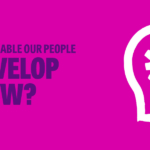Increase your people’s performance by empowering senior staff
When it comes to unlocking your people’s potential, few methods are as effective as running an internal mentoring programme. It’s a powerful development tool that can help unlock your people’s potential and increase their contribution to the organisation’s objectives.
It has benefits for the employees being mentored, of course, but mentors also benefit greatly from the experience. And what about the organisation? Mentoring programmes are easy to set up, increase retention rates and encourage knowledge sharing. What’s not to like?
It would seem that setting up an internal mentoring programme is a no-brainer for any business hoping to promote a culture of learning. However, there are a few guidelines to follow to ensure your efforts produce the right results.
Here are our top tips for designing and rolling out a successful internal mentoring programme within your organisation.
What is mentoring?
Coaching, mentoring, shadowing, managing… Figuring out the difference between all these terms can be challenging (fortunately, we published an article explaining the main difference between coaching, mentoring and managing).
In short, mentoring is the practice of assigning a member of staff to support another person with the aim of accelerating their development. This could mean helping a junior employee to increase their capability in a particular area, supporting someone as they return to work after a period of leave, or showing a newly appointed person the ropes after a promotion.
We are seeing a trend emerge for reverse mentoring, with younger staff teaching older colleagues how to use technology, for example. The possibilities are endless, and can go far beyond onboarding a new recruit.
What are the benefits of mentoring?
Mentoring has proven to have many benefits. Junior employees get to discuss their problems or ideas in a safe environment, and to receive advice from a more experienced member of staff. Mentors can also open doors for their mentees, often through networking opportunities. In return, the former get to improve their leadership capabilities, receive recognition for their work and develop new skills.
And the list of perks doesn’t end there. Whether mentees need to develop their confidence, hone their active listening or conflict management skills, or develop a more acute awareness of the issues experienced by some of the communities within your organisation, mentoring can help.
How to set up an internal mentoring programme
Here are our 7 simple steps for setting up a mentoring programme for your organisation.
1. Establish the main objective of your mentoring programme
It’s crucial to begin by asking yourself what you are hoping to achieve. What are the results you want to see by the end of the programme?
For example, you could have a diversity and inclusion (D&I) angle and hope for a positive shift in your internal culture. Or you could focus on a few high potential candidates to ensure they are ready for an upcoming promotion.
Knowing where you are headed will help you select the right format for your initiative. Based on your goals, shadowing, reverse mentoring, or even one-to-one coaching may be more suited to your needs.
2. Set up KPIs for your internal mentoring programme
If you know us, you’ll know that we love data. So, before setting anything in motion, we like to make sure there is a clear way to measure success.
Establish your starting benchmark as well as your objectives, and don’t forget to ask yourself what other activities you are building around your mentoring programme to support its delivery. For example, do you need a communication plan to reach your goals? Or to improve your L&D offering?
3. Make sure there is a good pairing process in place
Mentoring isn’t just about matching an experienced member of staff with a more junior one. It’s important to go further than this and collect enough information on both people, their career goals, their strengths, and their challenges to ensure a good fit between both participants.
4. Provide mentors with the right resources
Setting up a mentoring programme isn’t as simple as choosing a few senior employees and giving them responsibility over newer members of staff. They will require clear briefs on the project’s objectives, resources clearly stating what is required of a mentor, and the right training material.
“Make sure you make their jobs easier, while also giving them the freedom to find their own way. Resources such as checklists are great ways of doing this,” says Jo Taylor, MD at Let’s Talk Talent.
5. Free up people’s time so they can fully take part in your mentoring initiative
Asking people to mentor other people whilst also burying them under tons of work is the best way for your programme to fail.
Create an agreement form and make sure both participants and the organisation commit to making this happen.
6. Have an initial kickoff between your mentor and mentee
Give people the opportunity to get to know each other better before launching into the programme.
An initial kickoff will allow both parties to state their objectives, understand their preferred learning methods and, more importantly, break the ice before they launch into work-related topics.
7. Schedule regular check-ins with mentors and mentees
Before you roll out your initiative, ask yourself how you will support both the mentor and the mentee, and create firm guidelines from the start.
Once the programme is in full swing, check-in regularly on both parties to determine how things are going, what’s working, and what isn’t.
Setting your internal mentoring programme up for success
Setting up a good mentoring initiative doesn’t require huge effort and provides much-needed opportunities for staff to learn new skills and deepen their knowledge.
At a time when organisations are struggling to attract and retain great people, it is a fairly cost-effective way to encourage collaboration and knowledge sharing, and to provide development opportunities. Whether it’s through career progression, managerial skills, a specialism in a particular area, or increased awareness of social issues such as equality, diversity and inclusion, there is a way to use your internal mentoring programme to improve your internal culture, and your organisation’s performance.
Just remember that you’ll need to ensure that both your mentors and their mentees have the support they need. And more importantly, the room to grow and make mistakes.
Follow the tips above and take this amazing opportunity to create a culture of learning within your organisation. After all, you already have the people to do this in-house!
Do you need some help getting started with your internal mentoring programme? Book a call with us and let’s set up a briefing meeting. Or visit our Coaching services page for more free resources.




